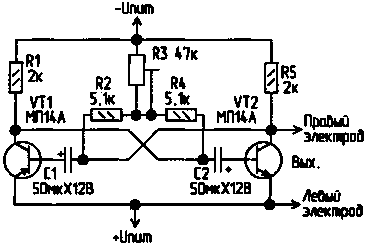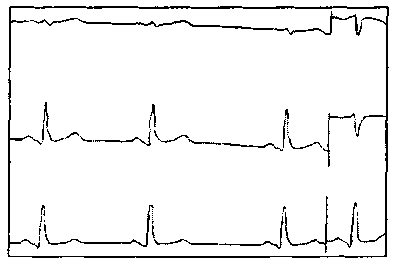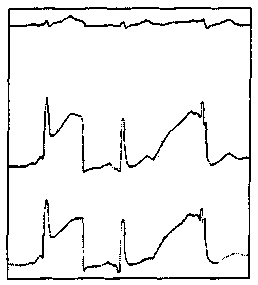
|
|
Heart passions. Encyclopedia of radio electronics and electrical engineering
Encyclopedia of radio electronics and electrical engineering / Electronics in medicine One day, on the eve of April 1st, a familiar doctor played a great prank on me. I decided to repay him in kind. He "sat" in the district clinic on an electrocardiograph, and the first thought was, using the tool that I had - a little knowledge of electrical engineering, to change his testimony. I had to turn over a decent amount of medical literature in the library, from which I learned nothing, except that this device captures the electrical impulses of the working heart muscle and displays them graphically. And the nature of the disease is judged mainly by the amplitude and shape of the pulses measured from different points. First of all, it was necessary to assemble a generator with a repetition rate of 50 to 150 pulses per minute. For this purpose, I used a multivibrator circuit, for reasons of its simplicity and small dimensions (Fig. 1). When powered by a Krona battery (9 V), the pulse frequency varied within the required limits with a trimming resistor R3. Having checked the shape of the pulses on the oscilloscope, I made sure that it is far from rectangular.
The impulses had a smooth rise and a sharp decline (Fig. 2). I connected the output of the multivibrator directly to the electrodes that I placed on the hips. The dimensions of the electrodes were selected in such a way that the amplitude of the "additional" impulses at the place where the cardiograph sensors were attached did not exceed the amplitude of the impulses of the heart muscle. Structurally, I placed the whole scheme in a matchbox and sewed it into swimming trunks (since they do not need to be removed during examination). As electrodes, I used plates of white tinned tin with dimensions of 60x40 mm, with rounded corners (so as not to injure the skin) and curved in the shape of the thigh (for better contact). I also sewed the electrodes into the trunks on the sides.
For better current flow, I used a solution of table salt (30%). In this case, a slight tingling sensation was felt in the area of contact with the electrodes. The side of the electrodes in contact with the body must be tinned without fail, otherwise the tin would quickly oxidize. The positive electrode must be on the left thigh, otherwise the polarity of the pulses will be opposite to the heart. And now, fully "equipped", I go to the clinic, explaining that I felt "something wrong" with my heart. My friend looked at me a little suspiciously (I had never complained before), but did not refuse. Here comes my "finest hour"! After the first examination, the entire medical staff of the polyclinic was smitten. All the specialists who knew at least a little in cardiology gathered. They discussed me for a very long time, not hiding their astonishment. Listening, tapping and listening again, they concluded that I had chronic heart failure, heard some noises and incomplete closure (or opening?!) of the right ventricular valve. No one has been able to give me an accurate diagnosis. And then they gave a referral to the hospital for further examination. I decided to hold on to the end. For several days, I was repeatedly checked, tested, fed with vitamins and forced to do therapeutic exercises. It was terribly tiring, and my zeal to "wipe my nose" at the medical luminaries quickly faded. Began to think about the ways of "withdrawal". Luckily, the battery came to the rescue. It gradually "sat down", and the amplitude of false impulses became smaller. I was told that things were getting better. At last I was completely "cured" and solemnly sent home. Then you should have seen the face of my friend when I told him everything and showed him the "artificial heart"!
For reference, in Fig. 3 I give a cardiogram of healthy heart function, and in Fig. 4 - with a multivibrator, where characteristic triangular impulses are visible, going a little out of step with the heart. This is the main drawback of this scheme. By and large, it was necessary to synchronize the operation of the generator with the heart rate, but this is a separate conversation.
In addition, when the cardiograph sensors move around the body, the amplitude of false impulses changes greatly, which makes it quite easy to localize the location of the signal source. Author: V.Yakovlev, Petrikov, Gomel region; Publication: N. Bolshakov, rf.atnn.ru
Machine for thinning flowers in gardens
02.05.2024 Advanced Infrared Microscope
02.05.2024 Air trap for insects
01.05.2024
▪ Plastic planes getting ready to take off ▪ Women in sports will overtake men in 2156 ▪ All the most valuable companies in the world are from the IT sector ▪ Monitor Iiyama ProLite X3291HS ▪ Prototype smart glasses with autofocus
▪ section of the site Funny puzzles. Article selection ▪ video editing article. Glue language. video art ▪ article Who took the first photo? Detailed answer ▪ article Chebrets. Legends, cultivation, methods of application ▪ article Chinese clock - timer. Encyclopedia of radio electronics and electrical engineering
Home page | Library | Articles | Website map | Site Reviews www.diagram.com.ua |






 Arabic
Arabic Bengali
Bengali Chinese
Chinese English
English French
French German
German Hebrew
Hebrew Hindi
Hindi Italian
Italian Japanese
Japanese Korean
Korean Malay
Malay Polish
Polish Portuguese
Portuguese Spanish
Spanish Turkish
Turkish Ukrainian
Ukrainian Vietnamese
Vietnamese




 Leave your comment on this article:
Leave your comment on this article: